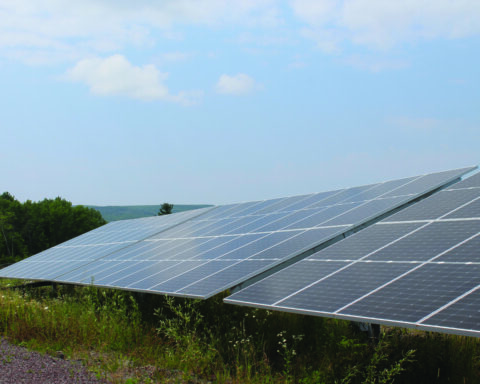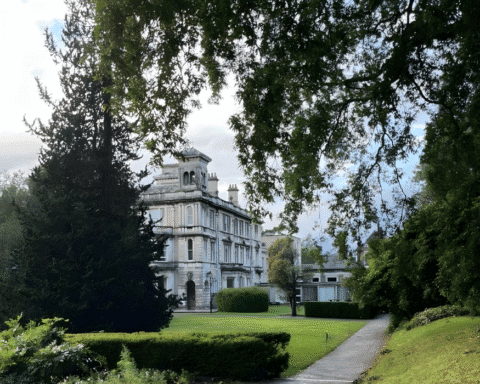One July morning this year, offices across Ethiopia closed their doors. By mid-afternoon, nearly 15 million citizens – students, farmers, civil servants, even priests – had put down pens and tools to take up shovels. In that single day, they planted some 355 million seedlings. One of those green ambassadors was Ayanaw Behailu, 15, who said he was “very happy to see the creation of greener areas across Addis [Ababa],” the capital city.
The urgency is clear. More than 70% of Ethiopia’s territory faces desertification, threatening more than 40 million people. Launched in 2019, the Green Legacy Initiative (GLI) is the country’s audacious response: a bid to plant 50 billion trees by 2026. But more than a reforestation drive, the GLI is ecological statecraft – an attempt to braid the environment, economy and national identity through trees.
“The Green Legacy is not a campaign,” says Eliane Ubalijoro, CEO of the Center for International Forestry Research and World Agroforestry, a Nairobi-based research institute that has worked closely with Ethiopia on restoration. “It is a reimagining of how a country can build ecological infrastructure as a foundation for economic renewal.”
Mass mobilization as policy
Each year, more than 20 million Ethiopians take part in the GLI. Schools integrate tree planting into lessons. Churches and mosques turn holy days into planting days. Ministries coordinate calendars to maximize labour around the rainy season. Across the country, 120,000 nurseries raise seedlings and train communities in their care.
The effort has already generated 767,000 jobs – nursery managers, forestry agents and seasonal workers – linking ecological recovery directly to livelihoods. In rural Ethiopia, where incomes are fragile, these jobs carry real weight. Restoration has become not an external aid project but a national civic duty.
This model breaks with Ethiopia’s past. For decades, the country was one of the world’s largest per-capita recipients of foreign aid – more than US$4 billion annually between 2018 and 2022. The GLI asserts an alternative: ecological sovereignty rooted in local agency. “We are not planting trees to meet donor metrics,” Ubalijoro emphasizes. “We are planting to anchor food systems, water cycles and national dignity.”
That vision is now enshrined in law. In 2024, Ethiopia passed Proclamation No. 1361, dedicating 0.5% to 1% of federal revenue (US$40 to $80 million annually) to a Green Legacy and Landscape Restoration Special Fund. Few countries have gone this far in legally binding restoration to national budgets.
Planting is only the beginning. What matters is survival, governance and care.
– Eliane Ubalijoro, CEO, Center for International Forestry Research and World Agroforestry
Ethiopia’s land degradation is not just ecological; it is political. Centuries of imperial expansion, Cold War–era coups, and cycles of authoritarianism and reform shaped how land is owned and managed. Famines of the 1980s were worsened by degraded soil, mismanaged agriculture and civil conflict. For decades, land was both a symbol and casualty of contested authority.
Against this backdrop, the GLI marks a departure. It channels Ethiopia’s long tradition of state-led mobilization but reorients it from dependency toward sovereignty. Instead of donor-driven projects, the state itself defines success: not just trees planted, but ecosystems restored, livelihoods created and national identity renewed.
Forests are essential infrastructure
Where Global North programs often reduce forests to carbon math, Ethiopia resists such flattening. Here, trees are framed as ecological infrastructure – living systems that stabilize soil, recharge aquifers, buffer droughts and anchor food security.
The initiative is not without challenge. Seedling survival rates sometimes fall below 60% as a result of drought, grazing or limited follow-up. Forest ecologist Tadesse Habtamu from Jimma University, in Jimma, Ethiopia, cautions against the pace imposed by the program. In an interview, he identifies issues related to “lack of technical oversight, concerns over biodiversity from mixing plant species and the absence of data on seedling survival.”
Failures here are treated as lessons, not footnotes. Government agencies track survival rates, adjust planting schedules and invest in training – an adaptive approach that strengthens the program each season. By contrast, donor-funded projects typically have their own review and audit cycles, but political and institutional incentives can slow response to negative findings. Ethiopia’s Green Legacy avoids this inertia because its success is defined, measured and corrected from within.
For farmers like Bercele Bayisa, the stakes are personal. He recalls how his district was once “very forested and full of wildlife,” until poverty forced families to clear trees for firewood. For him, GLI is about repairing the rupture between survival and stewardship.
National cohesion through trees
Planting days are more than labour – they are pedagogy. As public offices close and classrooms move outdoors, citizens are drawn into the narrative of national regeneration. These rituals help spark ecological curiosity and cultural ownership, especially among youth and rural communities.
At the same time, GLI has produced tangible environmental returns that reinforce civic pride. In reforested areas, project evidence shows that planting a single species has triggered the return of more than 10 other kinds of trees. The replanting effort has restored water cycles, bolstered soil and even coaxed migratory wildlife like colobus monkeys back into former habitats. Recent monitoring shows that annual soil erosion plunged from 1.9 billion tonnes to 208 million tonnes, shielding farmland and safeguarding dam infrastructure.
The outcome? Communities that are environmentally aware and emotionally invested. According to a 2023 policy brief by the Ethiopian Economics Association, many farm households report that they recognize the benefits of the GLI and are willing to allocate part of their own budget for future tree-planting initiatives.
This is how the GLI builds genuine cohesion: by inviting Ethiopia’s 80-plus ethnic groups into a co-created act of belonging, one rooted not only in memory and hope but in restored water, soil and life.
“Planting is only the beginning,” Ubalijoro warns. “What matters is survival, governance and care.”
Canada’s fragmented approach
Contrast this with Canada, home to vast forests and world-class institutions. In 2019, the federal government launched its 2 Billion Trees (2BT) program, aiming to plant that number of saplings by 2031. The government hoped to leverage the power of tree carbon capture in pursuit of net-zero emissions targets. But in its first two years, just 2.3% of the two billion trees were planted, according to the auditor general. In 2023, it warned that Canada not only risked missing its tree-planting ambitions, but that the expected emission reductions would occur much later.
Following that scathing assessment, the government picked up the pace. In August, it reported that the program had secured agreements to plant nearly one billion trees since its launch in 2021 and that to date, more than 228 million were in the ground. Its tree-planting agreements extend across 11 provinces and territories, 58 Indigenous partners, 30 municipalities and 88 non-governmental organizations.
RELATED
Massive wildfires are forcing governments worldwide to budget more for disaster
How East Africa’s women-led poultry co-ops are feeding communities when global markets fail
A novel investing tool is improving how conservation gets funded
But critics say implementation is divided among the various stakeholders, sometimes with little coordination. Even established actors such as the Forest Stewardship Council (FSC) Canada – managing forests with attention to soil, water, wildlife and people – have had limited involvement. “Planting a tree is an important act, but stewardship is about the entire ecosystem,” says Monika Patel, FSC Canada’s CEO. “That’s where resilience comes from.” Without integration, she warns, the program risks being just numbers on a page.
More fundamentally, I would argue, Canada has not asked what a tree is for. Policy often frames trees as carbon sinks or timber. What’s missing is the cultural reverence I see on display in Ethiopia.
Some Indigenous Nations have led the way. The Tŝilhqot’in Nation in British Columbia has established its own forest law, grounded in relational stewardship rather than yield targets. Others, like the Innu Nation, have used modern treaties to reclaim control over forest lands.
But these models remain exceptions, not norms.
Ethiopia’s Green Legacy shows that climate solutions need not be Global North–designed to be legitimate. It is not charity-adjacent; it is sovereign. Trees are treated as both cultural anchors and ecological infrastructure. Citizens are invited not just to plant, but to belong.
As former Canadian member of Parliament Monte Solberg put it, “Planting a tree is a bet on the future . . . a labour of love.” Without that intimate connection, even the best-funded reforestation effort struggles to take root.
Ethiopia’s lesson is simple, but profound: before planting another tree, plant a vision. One that binds ecological survival to sovereignty, livelihoods and legacy.
Shilpa Tiwari is the founder of No Women No Spice and Isenzo Group. She is based in Canada and Tanzania.
The Weekly Roundup
Get all our stories in one place, every Wednesday at noon EST.





